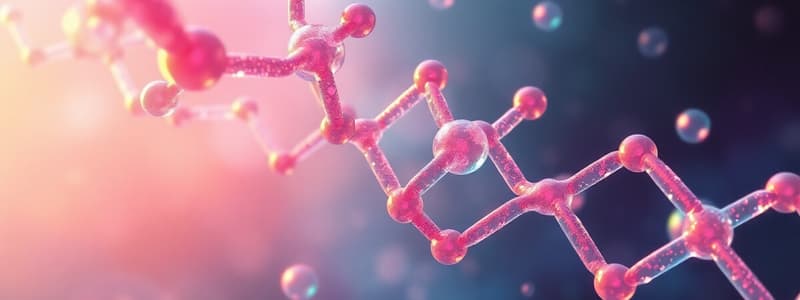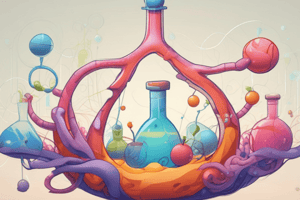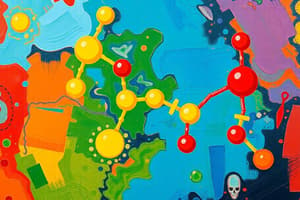Podcast
Questions and Answers
What blood type is expressed if neither GalNAc nor galactose is present?
What blood type is expressed if neither GalNAc nor galactose is present?
- AB
- B
- O (correct)
- A
Which type of glycosidic bond is found in starch?
Which type of glycosidic bond is found in starch?
- Alpha glycosidic bonds (correct)
- Delta glycosidic bonds
- Beta glycosidic bonds
- Gamma glycosidic bonds
What is the primary function of intestinal disaccharidases?
What is the primary function of intestinal disaccharidases?
- To produce oligosaccharides
- To create monosaccharides (correct)
- To digest cellulose
- To disrupt alpha(1->4) bonds
Which transporter is responsible for the absorption of fructose in the intestine mucosal cells?
Which transporter is responsible for the absorption of fructose in the intestine mucosal cells?
What blood glucose concentration, if maintained for a long time, is associated with potential vascular damage?
What blood glucose concentration, if maintained for a long time, is associated with potential vascular damage?
What is the general chemical formula for carbohydrates?
What is the general chemical formula for carbohydrates?
Which of the following best describes isomers?
Which of the following best describes isomers?
What suffix is characteristically added to the name of carbohydrates?
What suffix is characteristically added to the name of carbohydrates?
What is the primary type of functional group in aldose sugars?
What is the primary type of functional group in aldose sugars?
A monosaccharide with a ketone group is classified as a:
A monosaccharide with a ketone group is classified as a:
What type of chemical bond is formed between two monosaccharides when creating a disaccharide?
What type of chemical bond is formed between two monosaccharides when creating a disaccharide?
Which disaccharide is composed of a glucose molecule and a fructose molecule?
Which disaccharide is composed of a glucose molecule and a fructose molecule?
Which of the following polysaccharides is used for structural purposes in plants?
Which of the following polysaccharides is used for structural purposes in plants?
Which polysaccharide is found in the exoskeleton of insects?
Which polysaccharide is found in the exoskeleton of insects?
What structural component is at the center of a glycogen molecule?
What structural component is at the center of a glycogen molecule?
Which characteristic of amylopectin allows for rapid glucose retrieval?
Which characteristic of amylopectin allows for rapid glucose retrieval?
Which of the following is a characteristic of proteoglycans?
Which of the following is a characteristic of proteoglycans?
What is a primary function of glycosaminoglycans (GAGs)?
What is a primary function of glycosaminoglycans (GAGs)?
How do glycoproteins differ from proteoglycans in terms of their composition?
How do glycoproteins differ from proteoglycans in terms of their composition?
Which of the following is NOT a typical function of membrane-bound glycoproteins?
Which of the following is NOT a typical function of membrane-bound glycoproteins?
What is the significance of glycosylation in protein synthesis?
What is the significance of glycosylation in protein synthesis?
What determines whether a blood group is classified as A or B?
What determines whether a blood group is classified as A or B?
Which of the following components of the extracellular matrix are NOT mentioned in the text?
Which of the following components of the extracellular matrix are NOT mentioned in the text?
Flashcards
What are carbohydrates?
What are carbohydrates?
Carbohydrates are a group of carbonyl compounds (aldehydes or ketones) containing several hydroxyl groups.
How are carbohydrates classified?
How are carbohydrates classified?
Carbohydrates are classified by the number of sugar units they contain. Monosaccharides are single sugar units, disaccharides are two sugars linked, and polysaccharides are many sugars linked together.
What is a monosaccharide?
What is a monosaccharide?
A monosaccharide is a simple sugar molecule that cannot be broken down into smaller sugar units.
What is a disaccharide?
What is a disaccharide?
Signup and view all the flashcards
What is a polysaccharide?
What is a polysaccharide?
Signup and view all the flashcards
What is the difference between an aldose and a ketose?
What is the difference between an aldose and a ketose?
Signup and view all the flashcards
How are monosaccharides classified by the number of carbons?
How are monosaccharides classified by the number of carbons?
Signup and view all the flashcards
What is glycogen?
What is glycogen?
Signup and view all the flashcards
What is starch?
What is starch?
Signup and view all the flashcards
What is cellulose?
What is cellulose?
Signup and view all the flashcards
Amylopectin
Amylopectin
Signup and view all the flashcards
Amylose
Amylose
Signup and view all the flashcards
Proteoglycans
Proteoglycans
Signup and view all the flashcards
Glycosaminoglycans (GAGs)
Glycosaminoglycans (GAGs)
Signup and view all the flashcards
Extracellular Matrix (ECM)
Extracellular Matrix (ECM)
Signup and view all the flashcards
Glycoproteins
Glycoproteins
Signup and view all the flashcards
Glycosylation
Glycosylation
Signup and view all the flashcards
Mucin
Mucin
Signup and view all the flashcards
Glucosidase
Glucosidase
Signup and view all the flashcards
Cellulose
Cellulose
Signup and view all the flashcards
Intestinal Disaccharidase
Intestinal Disaccharidase
Signup and view all the flashcards
SGLT-1 (Sodium-dependent Glucose Cotransporter 1)
SGLT-1 (Sodium-dependent Glucose Cotransporter 1)
Signup and view all the flashcards
Absorption of Monosaccharides
Absorption of Monosaccharides
Signup and view all the flashcards
Study Notes
Carbohydrates Overview
- Carbohydrates are a group of carbonyl compounds (aldehydes or ketones) that also contain several hydroxyl groups.
- The general formula for carbohydrates is (CH₂O)ₙ.
- Carbohydrates can be classified by the number of monomers: monosaccharides, disaccharides, oligosaccharides, polysaccharides.
Carbohydrate Objectives
- Recognize the general structure of carbohydrates.
- Classify carbohydrates.
- Recognize disaccharides.
- Recognize polysaccharides.
- Explain carbohydrate-modified protein structures and their functions.
- Explain the digestion of carbohydrates.
Carbohydrate Structure and Classification
- Key components include carbonyl groups (aldehydes or ketones) and hydroxyl groups.
- Aldoses have an aldehyde group at the end of the carbon chain.
- Ketoses have a ketone group within the carbon chain.
- The number of carbons categorized carbohydrates as trioses, tetroses, pentoses, hexoses, heptoses, and nonoses, among others.
- Isomers have the same chemical formula but different structures.
Monosaccharides
- The simplest carbohydrates.
- Examples include glucose, fructose, and galactose.
- Important for energy and building blocks.
- Can exist in linear or ring forms.
- The presence of an aldehyde or ketone group is important for their role.
- Classified as aldoses or ketoses based on the functional group.
- Specific types of carbohydrates have specific roles based on the placement of oxygen and/or hydroxyl groups.
Disaccharides
- Two monosaccharides joined together.
- Examples include sucrose, lactose, and maltose.
- Joined by a glycosidic bond.
- Glycosidic bonds are crucial for joining molecules.
Polysaccharides
- Many monosaccharides linked together to form long chains.
- Examples include glycogen, starch, and cellulose.
- Glycogen and starch are energy storage molecules.
- Cellulose is a structural component in plant cell walls.
- They have different structures, which determine their function; (i.e., linear or branched).
Protein-Carbohydrate Structures
- Carbohydrates can combine with proteins to form glycoproteins and proteoglycans.
- Glycans are short sugar chains.
- A proteoglycan is a protein and a carbohydrate.
- Glycosylation is a common post-translational protein modification where sugar chains are added to the protein after formation in the cell.
- Many molecules have glycoproteins.
- Glycoproteins are often found on the cell surface.
Digestion of Carbohydrates
- Enzymes break down glycosidic bonds.
- Different enzymes are needed for different types of glycosidic bonds.
- Carbohydrates are broken down into smaller components during digestion to be absorbed into the body.
- Humans cannot digest cellulose, but some microorganisms can.
Absorption of Monosaccharides
- Monosaccharides are absorbed by cells in the small intestine.
- Specific transport proteins (e.g., SGLT-1, GLUT-5).
- Blood glucose levels are carefully regulated.
- Glucose is crucial for energy and brain function.
Other important notes:
- Different types of carbohydrates have different roles in the body, from energy storage to structural support.
- The structure of carbohydrate molecules significantly affects their function.
- Understanding carbohydrate digestion and absorption is key for maintaining blood glucose homeostasis.
Studying That Suits You
Use AI to generate personalized quizzes and flashcards to suit your learning preferences.




